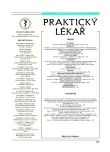Paresis of the facial nerve
Authors:
L. Steidl
Authors‘ workplace:
Neurolog, Olomouc
Published in:
Prakt. Lék. 2005; 85(5): 289-292
Category:
Diagnostis
Overview
Described are symptoms of the supranuclear, nuclear, infranuclear involvement of n. facialis and their different clinical picture. Topognosis, the determination of the level of the lesion, is of prognostic significance in the affection of the nerve. An important contribution to the determination of prognosis in facial paralysis is sound knowledge of the clinical picture and an EMG investigation with electrostimulation of the nerve. Conservative treatment with steroids and antiviral agents is the most effective. Surgical treatment with revision of the nerve in the fallopian canal is left for atypical cases. Dealt with are inflammatory paralyses; Guillain-Barré, Ramsey-Hunt, Banworth’s, and Melkersson-Rosenthal syndromes; paralyses in the pregnant, in diabetics; congenital, traumatic, and tumorous paralyses.
Key words:
Bell’s paralysis – topognosis of the facial nerve – Bannworth’s syndrome – Melkersson-Rosenthal syndrome – Guillant-Baré syndrome – various etiologies of facial nerve paralysis.
Labels
General practitioner for children and adolescents General practitioner for adultsArticle was published in
General Practitioner

2005 Issue 5
Most read in this issue
- Sjögren’s syndrome – a case of delayed diagnosis of malignant lymphoma with neuropsychiatric manifestations
- Paresis of the facial nerve
- The terminology of microorganisms
- Psycho-social consequences of the impairment of physical integrity
